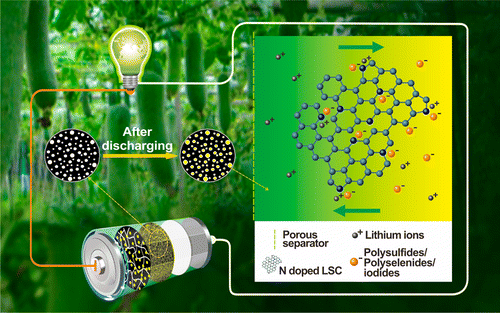Loofah-based material could give lithium batteries a boost

Today's mobile lifestyle depends on rechargeable lithium batteries. But to take these storage devices to the next level—to shore up the electric grid or for widespread use in vehicles, for example—they need a big boost in capacity. To get lithium batteries up to snuff for more ambitious applications, researchers report in the journal ACS Applied Materials & Interfaces a new solution that involves low-cost, renewable loofah sponges.
The lithium-ion batteries that power most of our devices still have some room for improvement. But some experts predict that even when these batteries are fully optimized, they still will not be able to meet the power needs for larger-scale applications, such as taking a car 500 miles on one charge. Scientists looking to go beyond lithium-ion have turned to lithium-sulfur and other options. But a major challenge to commercializing these technologies remains: The cathodes crumble over time, leading to progressively lower capacity. Shanqing Zhang, Yanglong Hou, Li-Min Liu and colleagues wanted to find a way to stabilize these alternatives.
The researchers developed a "blocking" layer of highly conductive, porous carbon derived from a loofah sponge. The loofah-derived membrane helped prevent the cathode from dissolving in lithium-sulfur, lithium-selenium and lithium-iodine batteries—and all three types performed well consistently over 500 to 5,000 cycles. The loofah sponge carbon could be the advance needed to move these batteries forward in a low-cost, sustainable way, the researchers say.
More information: Xingxing Gu et al. Multifunctional nitrogen-doped loofah sponge carbon blocking layer for high performance rechargeable lithium batteries, ACS Applied Materials & Interfaces (2016). DOI: 10.1021/acsami.6b02378
Abstract
Low-cost, long-life, and high-performance lithium batteries not only provide an economically viable power source to electric vehicles and smart electricity grids but also address the issues of the energy shortage and environmental sustainability. Herein, low-cost, hierarchically porous, and nitrogen-doped loofah sponge carbon (N-LSC) derived from the loofah sponge has been synthesized via a simple calcining process and then applied as a multifunctional blocking layer for Li–S, Li–Se, and Li–I2 batteries. As a result of the ultrahigh specific area (2551.06 m2 g–1), high porosity (1.75 cm3 g–1), high conductivity (1170 S m–1), and heteroatoms doping of N-LSC, the resultant Li–S, Li–Se, and Li–I2 batteries with the N-LSC-900 membrane deliver outstanding electrochemical performance stability in all cases, i.e., high reversible capacities of 623.6 mA h g–1 at 1675 mA g–1 after 500 cycles, 350 mA h g–1 at 1356 mA g–1 after 1000 cycles, and 150 mA h g–1 at 10550 mA g–1 after 5000 cycles, respectively. The successful application to Li–S, Li–Se, and Li–I2 batteries suggests that loofa sponge carbon could play a vital role in modern rechargeable battery industries as a universal, cost-effective, environmentally friendly, and high-performance blocking layer.
Journal information: ACS Applied Materials and Interfaces
Provided by American Chemical Society




















